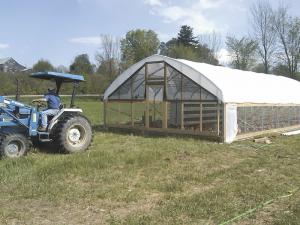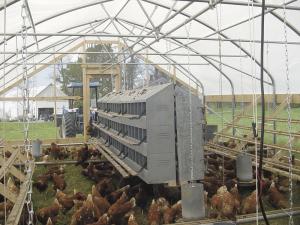Hoop House Chicken Coop Takes Pasture Production To New Level
Jeff Bahnck's high tunnel "hoop coop" takes pastured poultry to a new level. His 500 hens lay eggs, "spread" their own manure, and are never bothered by predators or weather. The chickens are totally enclosed, yet are free range and get fresh pasture every other day, thanks to the moveable hoop house Bahnck bought from Four Seasons Tools.
"The structure is varmint proof," he says. "And it's low maintenance. The waterers, feeders, nesting boxes and roosting perches are all hung from the hoop house structure. When it is time to move, all I have to do is hook up the tractor and slide it forward."
To move the "coop" house sideways, Bahnck raises the side frames and slides 3-in. pvc pipe under them in 4 places. He then rigs 6 pairs of chains, attached to the side of the house, in a series of equilateral triangles; the first three sets are secured to the side of the coop. The second two triangles are secured to the first three sets of chains. A final triangle of chains attaches to the second set of chains.
He then hooks his tractor to the point of the last triangle and slowly moves ahead. This distributes the pulling force evenly to all 4 points on the coop house frame. Spreader bars between the sides transfer the pull to the opposite side.
Regardless of which way he pulls the house, one thing is always the same. The nearly 500 hens get excited and crowd toward the sound of the tractor. They know fresh grass and fresh bugs are coming.
Bahnck likes the low-labor system. "I get up a little before dawn and walk out to let down the doors on the laying boxes," he says. "Then I go back to the house for a cup of coffee. At about 10 a.m. I stop by the coop to close up all but two laying boxes, fill the feeders and pick the eggs. They will have laid about 95 percent of their eggs by then."
The flock averages 33 dozen eggs a day, and Bahnck notes that they're all spoken for before they're laid. He sells them to several outlets, including a local deli chain that specializes in locally produced food.
Bahnck credits Greg Garbos of Four Seasons Tools for giving him a structure he could work with that fit the chickens' needs. Side walls were modified to only 5 ft. tall, and the overall structure is 20 ft. by 48 ft. Galvanized 1 1/2 by 2-in. mesh screening wraps around the entire house with an entry door for Bahnck. To shade the chickens, he used 75 percent shade cloth over the top of the house.
The hens quickly trained themselves to follow the advancing side into fresh grass. Initially Bahnck was concerned they might get pinned by the following edge of the moving coop. He designed swinging panels to encourage them along, yet allow them to escape if necessary.
"The lower pipe on the frame is 12 in. off the ground when the home is moving," explains Bahnck. "I used pipe strapping to fasten 2 by 8's to the pipe so they would keep the chickens in, yet they could flap with the contour of the ground. If a hen gets trapped against them, they will swing out of the way, and she'll get outside, but she won't get squashed."
Garbos says Bahnck and his wife Alethea are the first customers to use a moveable hoop house for chickens. He doesn't expect them to be the last.
"We sold them the frame, and Jeff and Alethea added everything they needed for the chickens," says Garbos. "It worked so well we are going to offer a kit with everything needed."
For Bahnck, a carpenter in a depressed economy, the chicken hoop house was a no-brainer. "Work was slow, and this was instant income," he says. "My wife raises and markets purebred Berkshires and Tamworths for the pasture fed market, so we knew how to market. We knew there was a niche in egg production that this system could fill."
Contact: FARM SHOW Followup, Jeff and Alethea Bahnck, 2175 East Street, Bridport, Vt. 05734 (alethea@gmavt.net); or Four Season Tools, 602 Westport Rd., Kansas City, Mo. 64111 (ph 816 444-7330; www.fourseasontools.com).

Click here to download page story appeared in.
Click here to read entire issue
Hoop House Chicken Coop Takes Pasture Production To New Level LIVESTOCK Poultry 33-5-3 Jeff Bahnck's high tunnel "hoop coop" takes pastured poultry to a new level. His 500 hens lay eggs, "spread" their own manure, and are never bothered by predators or weather. The chickens are totally enclosed, yet are free range and get fresh pasture every other day, thanks to the moveable hoop house Bahnck bought from Four Seasons Tools.
"The structure is varmint proof," he says. "And it's low maintenance. The waterers, feeders, nesting boxes and roosting perches are all hung from the hoop house structure. When it is time to move, all I have to do is hook up the tractor and slide it forward."
To move the "coop" house sideways, Bahnck raises the side frames and slides 3-in. pvc pipe under them in 4 places. He then rigs 6 pairs of chains, attached to the side of the house, in a series of equilateral triangles; the first three sets are secured to the side of the coop. The second two triangles are secured to the first three sets of chains. A final triangle of chains attaches to the second set of chains.
He then hooks his tractor to the point of the last triangle and slowly moves ahead. This distributes the pulling force evenly to all 4 points on the coop house frame. Spreader bars between the sides transfer the pull to the opposite side.
Regardless of which way he pulls the house, one thing is always the same. The nearly 500 hens get excited and crowd toward the sound of the tractor. They know fresh grass and fresh bugs are coming.
Bahnck likes the low-labor system. "I get up a little before dawn and walk out to let down the doors on the laying boxes," he says. "Then I go back to the house for a cup of coffee. At about 10 a.m. I stop by the coop to close up all but two laying boxes, fill the feeders and pick the eggs. They will have laid about 95 percent of their eggs by then."
The flock averages 33 dozen eggs a day, and Bahnck notes that they're all spoken for before they're laid. He sells them to several outlets, including a local deli chain that specializes in locally produced food.
Bahnck credits Greg Garbos of Four Seasons Tools for giving him a structure he could work with that fit the chickens' needs. Side walls were modified to only 5 ft. tall, and the overall structure is 20 ft. by 48 ft. Galvanized 1 1/2 by 2-in. mesh screening wraps around the entire house with an entry door for Bahnck. To shade the chickens, he used 75 percent shade cloth over the top of the house.
The hens quickly trained themselves to follow the advancing side into fresh grass. Initially Bahnck was concerned they might get pinned by the following edge of the moving coop. He designed swinging panels to encourage them along, yet allow them to escape if necessary.
"The lower pipe on the frame is 12 in. off the ground when the home is moving," explains Bahnck. "I used pipe strapping to fasten 2 by 8's to the pipe so they would keep the chickens in, yet they could flap with the contour of the ground. If a hen gets trapped against them, they will swing out of the way, and she'll get outside, but she won't get squashed."
Garbos says Bahnck and his wife Alethea are the first customers to use a moveable hoop house for chickens. He doesn't expect them to be the last.
"We sold them the frame, and Jeff and Alethea added everything they needed for the chickens," says Garbos. "It worked so well we are going to offer a kit with everything needed."
For Bahnck, a carpenter in a depressed economy, the chicken hoop house was a no-brainer. "Work was slow, and this was instant income," he says. "My wife raises and markets purebred Berkshires and Tamworths for the pasture fed market, so we knew how to market. We knew there was a niche in egg production that this system could fill."
Contact: FARM SHOW Followup, Jeff and Alethea Bahnck, 2175 East Street, Bridport, Vt. 05734 (alethea@gmavt.net); or Four Season Tools, 602 Westport Rd., Kansas City, Mo. 64111 (ph 816 444-7330; www.fourseasontools.com).
To read the rest of this story, download this issue below or click
here to register with your account number.








